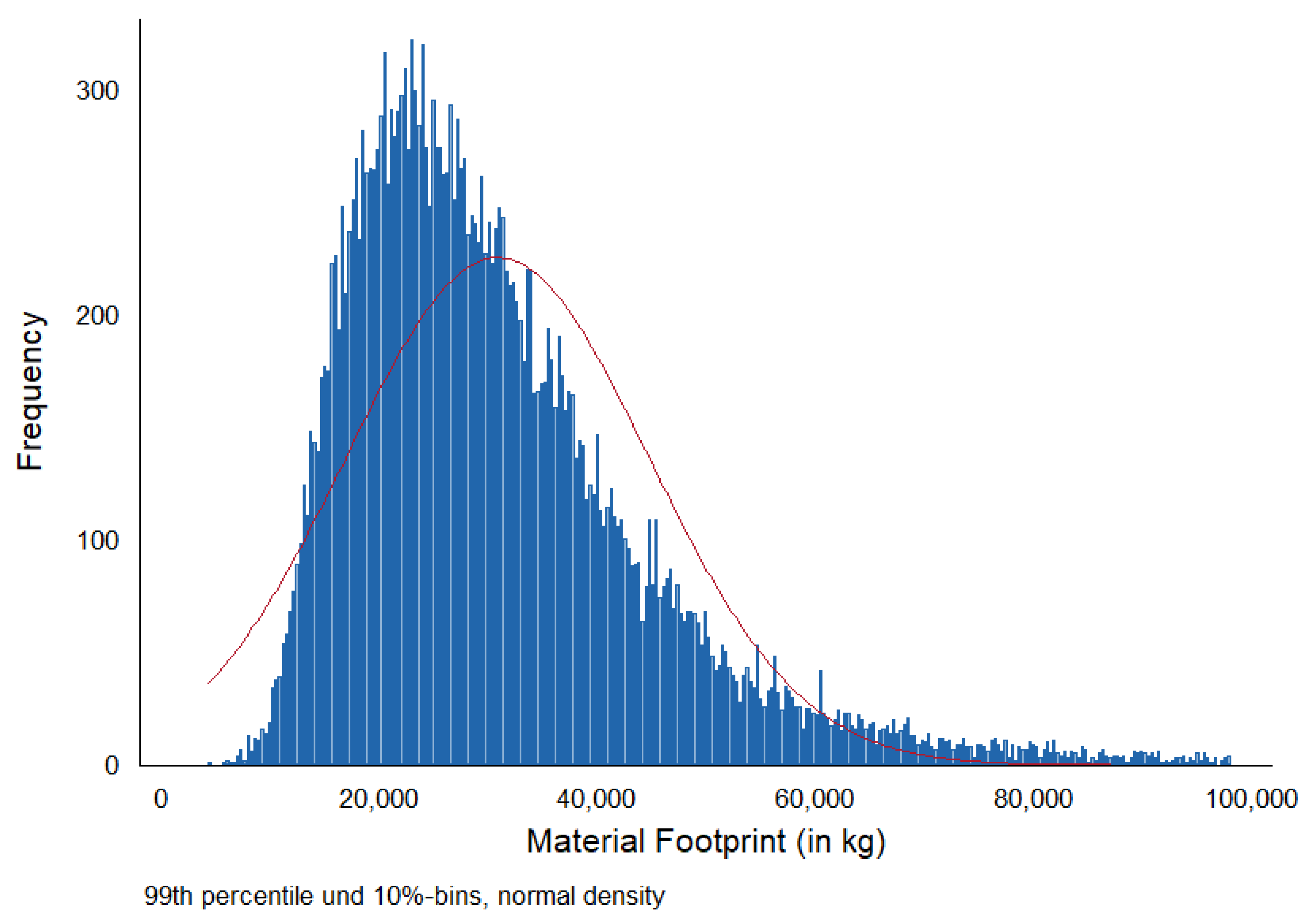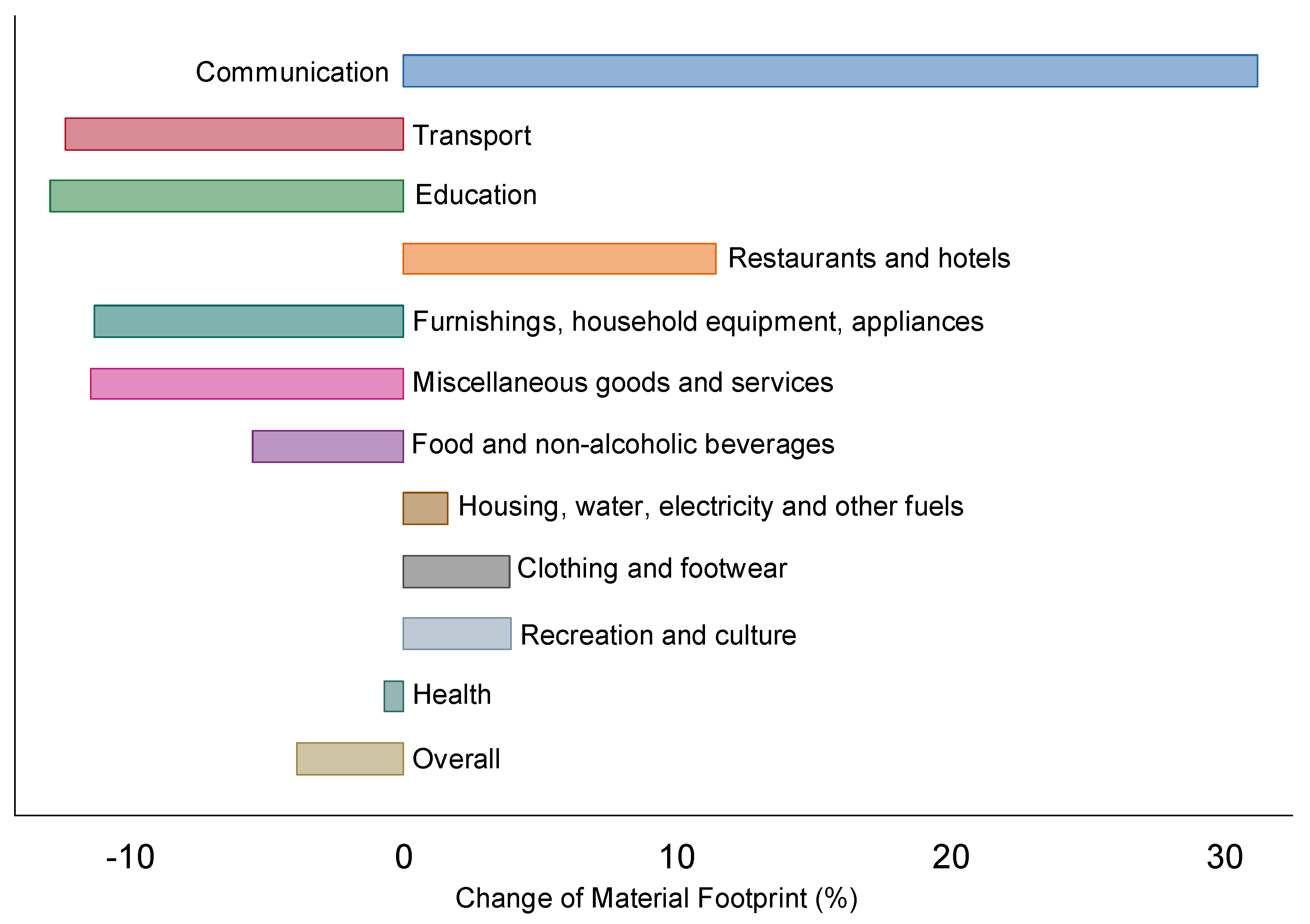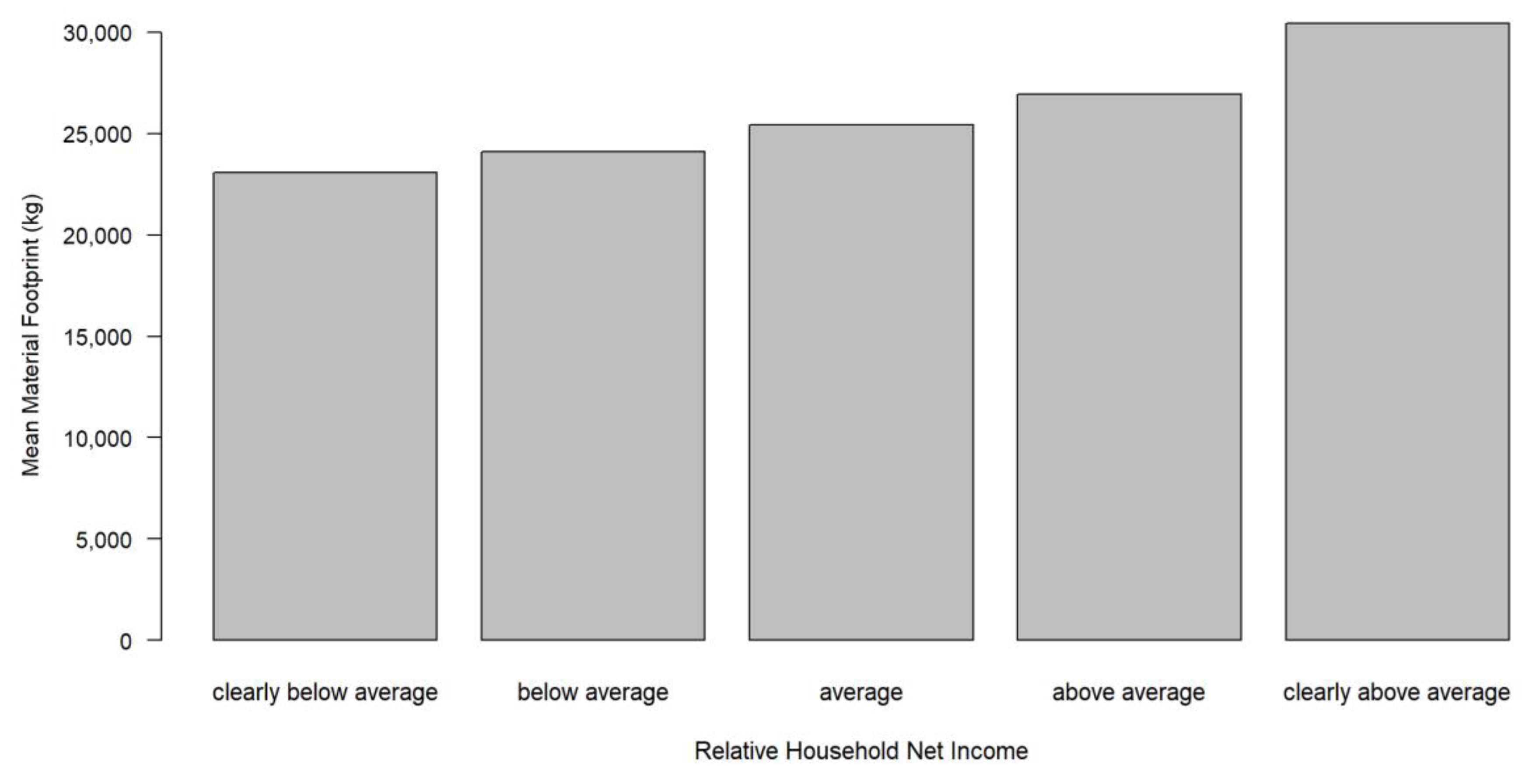Measure or Management?—Resource Use Indicators for Policymakers Based on Microdata by Households
Abstract
1. Introduction
2. Methodology
2.1. The Resource Consumption Indicator (RCI)
2.2. The Resource Lifestyle Footprint (RLF)
3. Results
3.1. Resource Consumption Indicator Based on Microdata EVS and Resource Intensities
3.2. Resource Lifestyle Footprint Based on Survey Data from an Online Web Tool
4. Discussion
4.1. Resource Consumption Indicator
4.2. Resource Lifestyle Footprint
5. Conclusions
5.1. Summary
5.2. Methods
- First, it enables a representative depiction of private household consumption.
- Second, private household consumption can be examined by looking at differentiated consumption categories such as energy or food and its shifts and changes for the past decades.
- Third, private household consumption can be examined by looking at differentiated population groups (disaggregated for example by income or age).
5.3. Policy Making
Author Contributions
Funding
Acknowledgments
Conflicts of Interest
Appendix A. Calculating the Material Footprint Based on Resource Intensities
References
- Steffen, W.; Rockström, J.; Richardson, K.; Lenton, T.M.; Folke, C.; Liverman, D.; Summerhayes, C.P.; Barnosky, A.D.; Cornell, S.E.; Crucifix, M.; et al. Trajectories of the Earth System in the Anthropocene. Proc. Natl. Acad. Sci. USA 2018, 115, 8252–8259. [Google Scholar] [CrossRef] [PubMed]
- Van Beers, D.; Grossi, F.; Brüggemann, N.; CRI, N.K.; CRI, D.W.; Mont, O.; Voytenko, Y.; UBA, C.L.; Robey, M.; Jones, M.; et al. Reflections and Lessons Learnt from EEA’s Work on Innovative Business Models for Sustainable Lifestyles; Working Paper for the European Topic Centre on Waste and Materials in a Green Economy; ETC/WMGE: Boeretang, Belgium, 2014. [Google Scholar]
- Reim, W.; Parida, V.; Örtqvist, D. Product–Service Systems (PSS) business models and tactics—A systematic literature review. J. Clean. Prod. 2015, 97, 61–75. [Google Scholar] [CrossRef]
- Lewis, M. Product-Service Systems. In Wiley Encyclopedia of Management; Cooper, C.L., Ed.; John Wiley & Sons, Ltd.: Chichester, UK, 2015; p. 1. ISBN 978-1-118-78531-7. [Google Scholar]
- Hankammer, S.; Steiner, F. Leveraging the sustainability potential of mass customization through product service systems in the consumer electronics industry. Procedia CIRP 2015, 30, 504–509. [Google Scholar] [CrossRef]
- European Parliament; Council of the European Union. Directive 2009/125/EC of The European Parliament and of the Council of 21 October 2009 Establishing a Framework for the Setting of Ecodesign Requirements for Energy-Related Products (Recast); Publications Office of the European Union: Brussels, Belgium, 2009. [Google Scholar]
- UNEP. International Trading Center 10YFP Consumer Information Programme for Sustainable Consumption and Production (CI-SCP)—Guidelines for Providing Product Sustainability Information; UNEP: Nairobi, Kenya, 2016. [Google Scholar]
- German Federal Government. Die Deutsche Nachhaltigkeitsstrategie 2016—der Weg in eine enkelgerechte Zukunft; German Federal Government: Berlin, Germany, 2016.
- UN. General Assembly Work of the Statistical Commission pertaining to the 2030 Agenda for Sustainable Development: Resolution; UN: New York, NY, USA, 2017; 25p. [Google Scholar]
- Buhl, J.; Teubler, J.; Liedtke, C.; Stadler, K. Ressourcenverbrauch private Haushalte NRW—Explorative Analyse. Final Report of the Funded Project “Konzeptionelle Analysen und Überlegungen zur Ausgestaltung einer Nachhaltigkeitsstrategie aus wissenschaftlicher Sicht” for the State Agency for Nature, Environment and Consumer Protection NRW (LANUV); Wuppertal Institute for Climate, Environment and Energy: Wuppertal, Germany, 2016. [Google Scholar]
- German Federal Government. Perspektiven für Deutschland: Fortschrittsbericht...; unsere Strategie für eine nachhaltige Entwicklung; Presse-und Informationsamt der Bundesregierung: Berlin, Germany, 2002.
- German Federal Government. Nationales Programm für nachhaltigen Konsum. Gesellschaftlicher Wandel durch einen nachhaltigen Lebensstil; German Federal Ministry for the Environment, Nature Conservation and Nuclear Safety: Berlin, Germany, 2017. Available online: https://www.bmu.de/fileadmin/Daten_BMU/Download_PDF/Produkte_und_Umwelt/nat_programm_konsum_bf.pdf (accessed on 20 November 2018).
- Bundesministerium für Umwelt, Naturschutz, Bau und Reaktorsicherheit (BMUB) Deutsches Ressourceneffizienz- programm II Programm zur nachhaltigen Nutzung und zum Schutz der natürlichen Ressourcen; BMUB: Berlin, Germany, 2016.
- Hölsgens, R.; Lübke, S.; Hasselkuß, M. Social innovations in the German energy transition: An attempt to use the heuristics of the multi-level perspective of transitions to analyze the diffusion process of social innovations. Energy Sustain. Soc. 2018, 8, 8. [Google Scholar] [CrossRef]
- Spangenberg, J.H. Design for Sustainability (DfS): Interface of Sustainable Production and Consumption. In Handbook of Sustainable Engineering; Kauffman, J., Lee, K.-M., Eds.; Springer: Dordrecht, The Netherlands, 2013; pp. 575–595. ISBN 978-1-4020-8938-1. [Google Scholar]
- Bringezu, S.; Ramaswami, A.; Schandl, H.; O’Brien, M.; Pelton, R.; Acquatella, J.; Ayuk, E.T.; Chiu, A.S.F.; Flanegin, R.; Fry, J.; et al. Assessing Global Resource Use: A Systems Approach to Resource Efficiency and Pollution Reduction; United Nations Environment Programme: Nairobi, Kenya, 2017; p. 99. [Google Scholar]
- Bringezu, S.; Schütz, H.; Saurat, M.; Moll, S.; Acosta-Fernández, J.; Steger, S. Europe’s resource use. Basic trends, global and sectoral patterns and environmental and socioeconomic impacts. In Sustainable Resource Management: Global Trends, Visions and Policies; Bringezu, S., Bleischwitz, R., Eds.; Greenleaf Publishing: Sheffield, UK, 2009; pp. 52–154. [Google Scholar]
- Lettenmeier, M.; Liedtke, C.; Rohn, H. Eight Tons of Material Footprint—Suggestion for a Resource Cap for Household Consumption in Finland. Resources 2014, 3, 488–515. [Google Scholar] [CrossRef]
- Speck, M.; Liedtke, C. Chancen und Grenzen nachhaltigen Konsums in einer ressourcenleichten Gesellschaft. Jahrbuch Nachhaltige Ökonomie 2016/2017: im Brennpunkt: Ressourcen-Wende; Metropolis-Verl: Marburg, Germany, 2016; pp. 255–269. [Google Scholar]
- Schmidt-Bleek, F. Das MIPS-Konzept: Weniger Naturverbrauch—mehr Lebensqualität durch Faktor 10; Droemer Knaur: München, Germany, 2000; ISBN 3-426-77475-5. [Google Scholar]
- Teubler, J.; Buhl, J.; Lettenmeier, M.; Greiff, K.; Liedtke, C. A Household’s Burden—The Embodied Resource Use of Household Equipment in Germany. Ecol. Econ. 2018, 146, 96–105. [Google Scholar] [CrossRef]
- Wiesen, K.; Saurat, M. Michael Lettenmeier Calculating the Material Input per Service Unit using the Ecoinvent Database. Int. J. Perform. Eng. 2014, 10, 357–366. [Google Scholar]
- Wiesen, K.; Wirges, M. From cumulated energy demand to cumulated raw material demand: The material footprint as a sum parameter in life cycle assessment. Energy Sustain. Soc. 2017, 7, 13. [Google Scholar] [CrossRef]
- Teubler, J.; Kiefer, S.; Liedtke, C. Metals for Fuels? The Raw Material Shift by Energy-Efficient Transport Systems in Europe. Resources 2018, 7, 49. [Google Scholar] [CrossRef]
- Saurat, M.; Ritthoff, M. Calculating MIPS 2.0. Resources 2013, 2, 581–607. [Google Scholar] [CrossRef]
- Greiff, K.; Teubler, J.; Baedeker, C.; Liedtke, C.; Rohn, H. Material and Carbon Footprint of Household Activities. In Living Labs: Design and Assessment of Sustainable Living; Keyson, D.V., Guerra-Santin, O., Lockton, D., Eds.; Springer International Publishing: Cham, Switzerland, 2017; pp. 259–275. ISBN 978-3-319-33527-8. [Google Scholar]
- Buhl, J.; Liedtke, C.; Bienge, K. How Much Environment Do Humans Need? Evidence from an Integrated Online User Application Linking Natural Resource Use and Subjective Well-Being in Germany. Resources 2017, 6, 67. [Google Scholar] [CrossRef]
- United Nations High Commissioner for Human Rights (OHCHR). A Human Rights Based Approach to Data—Leaving No One Behind in the 2030 Development Agenda; United Nations High Commissioner for Human Rights (OHCHR): Geneva, Switzerland, 2018. [Google Scholar]
- United Nations System Chief Executives Board for Coordination (CEB). Leaving No One Behind: Equality and Non-Discrimination at the Heart of Sustainable Development; United Nations: New York, NY, USA, 2017. [Google Scholar]
- United Nations. The Road to Dignity by 2030: Ending Poverty, Transforming All Lives and Protecting the Planet; United Nations: New York, NY, USA, 2014. [Google Scholar]
- Wood, R.; Stadler, K.; Bulavskaya, T.; Lutter, S.; Giljum, S.; de Koning, A.; Kuenen, J.; Schütz, H.; Acosta-Fernández, J.; Usubiaga, A.; et al. Global sustainability accounting—Developing EXIOBASE for multi-regional footprint analysis. Sustainability 2014, 7, 138–163. [Google Scholar] [CrossRef]
- Buhl, J.; Acosta, J. Work Less, Do Less? Working Time Reductions and Rebound Effects. Sustain. Sci. 2016, 11, 261–276. [Google Scholar] [CrossRef]
- Watson, D.; Acosta Fernandez, J.; Wittmer, D.; Pedersen, O.G. Environmental pressures from European consumption and production: A study in integrated environmental and economic analysis; Publications Office of the European Union: Luxembourg, 2013. [Google Scholar]
- Buhl, J. Revisiting Rebound Effects from Material Resource Use. Indications for Germany Considering Social Heterogeneity. Resources 2014, 3, 106–122. [Google Scholar] [CrossRef]
- Schmidt-Bleek, F. Der ökologische Rucksack. Wirtschaft für eine Zukunft mit Zukunft; Schmidt-Bleek, F., Ed.; Hirzel: Stuttgart, Germany, 2004. [Google Scholar]
- Liedtke, C.; Bienge, K.; Wiesen, K.; Teubler, J.; Greiff, K.; Lettenmeier, M.; Rohn, H. Resource Use in the Production and Consumption System—The MIPS Approach. Resources 2014, 3, 544–574. [Google Scholar] [CrossRef]
- Buhl, J.; Teubler, J.; Liedtke, C.; Stadler, K. Der Ressourcenverbrauch privater Haushalte in NRW. Uwf UmweltWirtschaftsForum Sustain. Manag. Forum 2017, 25, 255–264. [Google Scholar]
- Lettenmeier, M. A sustainable level of material footprint—Benchmark for designing one-planet lifestyles Materiaalijalanjäljen kestävä taso –mittapuu yhden planeetan elämäntapojen toteuttamiseen; Aalto University: Espoo, Finland, 2018. [Google Scholar]
- Kirby, P.; O’Mahony, T. Planning Future Pathways: Implications and Outcomes of Scenario Studies. In The Political Economy of the Low-Carbon Transition; Springer: New York, NY, USA, 2018; pp. 115–141. [Google Scholar]





| N (Sample Size) | Mean | Std.Dev. (Standard Deviation) | |||||||
|---|---|---|---|---|---|---|---|---|---|
| Variables | 2003 | 2008 | 2013 | 2003 | 2008 | 2013 | 2003 | 2008 | 2013 |
| Food and beverages | 42,744 | 44,088 | 42,792 | 3634.7 | 3831.69 | 3825.74 | 1933.35 | 2060.8 | 2100.27 |
| Clothing | 42,744 | 44,088 | 42,792 | 1646.34 | 1514.8 | 1577.43 | 1572.12 | 1569.62 | 1665.11 |
| Housing | 42,744 | 44,088 | 42,792 | 9449.24 | 9642.25 | 10,746.5 | 6337.31 | 4900.78 | 5129.06 |
| Furnishing | 42,744 | 44,088 | 42,792 | 1900.51 | 1624.52 | 1671.71 | 4191.31 | 3805.17 | 3702.8 |
| Health | 42,744 | 44,088 | 42,792 | 1332.44 | 1438.11 | 1552.15 | 3822.46 | 3694.82 | 4232.48 |
| Transport | 42,744 | 44,088 | 42,792 | 4610.35 | 4687.23 | 4628.17 | 11,824.1 | 10,489.9 | 11,369.6 |
| Communication | 42,744 | 44,088 | 42,792 | 896.51 | 833.13 | 821.45 | 668.83 | 527.96 | 554.92 |
| Recreation and Culture | 42,744 | 44,088 | 42,792 | 3807.11 | 3701.09 | 3575.99 | 4002.47 | 4512.23 | 4743.77 |
| Education | 42,744 | 44,088 | 42,792 | 298.38 | 292.53 | 272.98 | 865.56 | 1046.73 | 1070.36 |
| Hotels | 42,744 | 44,088 | 42,792 | 1477.48 | 1654.37 | 1782.77 | 1890.12 | 2143.4 | 2316.07 |
| Miscellaneous | 42,744 | 44,088 | 42,792 | 1379.76 | 1351.69 | 1297.62 | 1892.59 | 2103.99 | 1948.51 |
| Household size | 42,744 | 44,088 | 42,792 | 2.43 | 2.28 | 2.10 | 1.23 | 1.17 | 1.09 |
| NRW | 9223 | 7708 | 7823 | 1 | 1 | 1 | 0 | 0 | 0 |
| Consumption Categories | Resource Intensity (kg/€) |
|---|---|
| Food and beverages | 5.09 |
| Housing etc. | 3.18 |
| Furnishings etc. | 2.99 |
| Transport | 1.50 |
| Restaurants and hotels | 1.40 |
| Health | 0.60 |
| Education | 0.48 |
| Recreation and culture | 0.41 |
| Communication | 0.37 |
| Clothing | 0.19 |
| Miscellaneous | 0.19 |
| Groups of Consumption in Resource Calculator | Description of Category |
|---|---|
| Nutrition | diets, food waste, and consumption of foodstuffs and drinks |
| Housing | buildings, heat, and electricity use |
| Consumer Goods | appliances, clothes, furniture |
| Mobility | day-to-day travel with cars, bikes, public transport |
| Leisure | hobbies, sports, cultural activities |
| Vacation | vacation travel and accommodation |
| Statistic | N | Mean | Std. Dev. | Min | Max |
|---|---|---|---|---|---|
| Personal characteristics | |||||
| Female | 26,103 | 0.62 | 0.49 | 0 | 1 |
| Age | 24,596 | 36.00 | 12.00 | 18 | 71 |
| Schooling years | 26,118 | 14.00 | 3.20 | 9 | 21 |
| Occupational status | 18,463 | 3.00 | 1.10 | 1 | 4 |
| Unemployed | 18,463 | 0.14 | 0.35 | 0 | 1 |
| Household characteristics | |||||
| Household size | 44,238 | 2.20 | 1.00 | 1.00 | 6.00 |
| Number of children | 9119 | 1.60 | 0.71 | 1 | 4 |
| Size of dwelling (m2) | 30,482 | 95.00 | 47.00 | 7.00 | 300.00 |
| Subjective assessments | |||||
| Subjective health | 17,297 | 1.30 | 0.57 | −1 | 2 |
| Relative income | 22,125 | −0.41 | 1.00 | −2 | 2 |
| Life satisfaction | 26,041 | 7.30 | 1.80 | 1 | 10 |
| Social ties satisfaction | 17,690 | 1.00 | 0.71 | −2 | 2 |
| Lifestyle | |||||
| Diet | 44,317 | 2.20 | 0.84 | 1 | 4 |
| Vegetarian | 44,317 | 0.33 | 0.47 | 0 | 1 |
| Hobby hours | 44,091 | 8.00 | 12.00 | 0.00 | 75.00 |
| Days on vacation | 44,056 | 15.00 | 13.00 | 0 | 81 |
| Trips (in km) | 44,086 | 220.00 | 327.00 | 0.00 | 1,800.00 |
| Material Footprints (kg) | |||||
| Housing | 44,068 | 8722.00 | 4059.00 | 45 | 26,804 |
| Consumer goods | 44,068 | 2859.00 | 1161.00 | 2 | 6936 |
| Nutrition | 44,068 | 5160.00 | 1323.00 | 82 | 9145 |
| Leisure | 44,069 | 446.00 | 639.00 | 0 | 5113 |
| Mobility | 43,456 | 6682.00 | 6407.00 | 1 | 39,447 |
| Vacations | 44,068 | 1525.00 | 1532.00 | 0 | 10,200 |
| Overall Material Footprint | 44,068 | 25,897.00 | 10,041.00 | 2.711 | 76,570 |
© 2018 by the authors. Licensee MDPI, Basel, Switzerland. This article is an open access article distributed under the terms and conditions of the Creative Commons Attribution (CC BY) license (http://creativecommons.org/licenses/by/4.0/).
Share and Cite
Buhl, J.; Liedtke, C.; Teubler, J.; Bienge, K.; Schmidt, N. Measure or Management?—Resource Use Indicators for Policymakers Based on Microdata by Households. Sustainability 2018, 10, 4467. https://doi.org/10.3390/su10124467
Buhl J, Liedtke C, Teubler J, Bienge K, Schmidt N. Measure or Management?—Resource Use Indicators for Policymakers Based on Microdata by Households. Sustainability. 2018; 10(12):4467. https://doi.org/10.3390/su10124467
Chicago/Turabian StyleBuhl, Johannes, Christa Liedtke, Jens Teubler, Katrin Bienge, and Nicholas Schmidt. 2018. "Measure or Management?—Resource Use Indicators for Policymakers Based on Microdata by Households" Sustainability 10, no. 12: 4467. https://doi.org/10.3390/su10124467
APA StyleBuhl, J., Liedtke, C., Teubler, J., Bienge, K., & Schmidt, N. (2018). Measure or Management?—Resource Use Indicators for Policymakers Based on Microdata by Households. Sustainability, 10(12), 4467. https://doi.org/10.3390/su10124467







